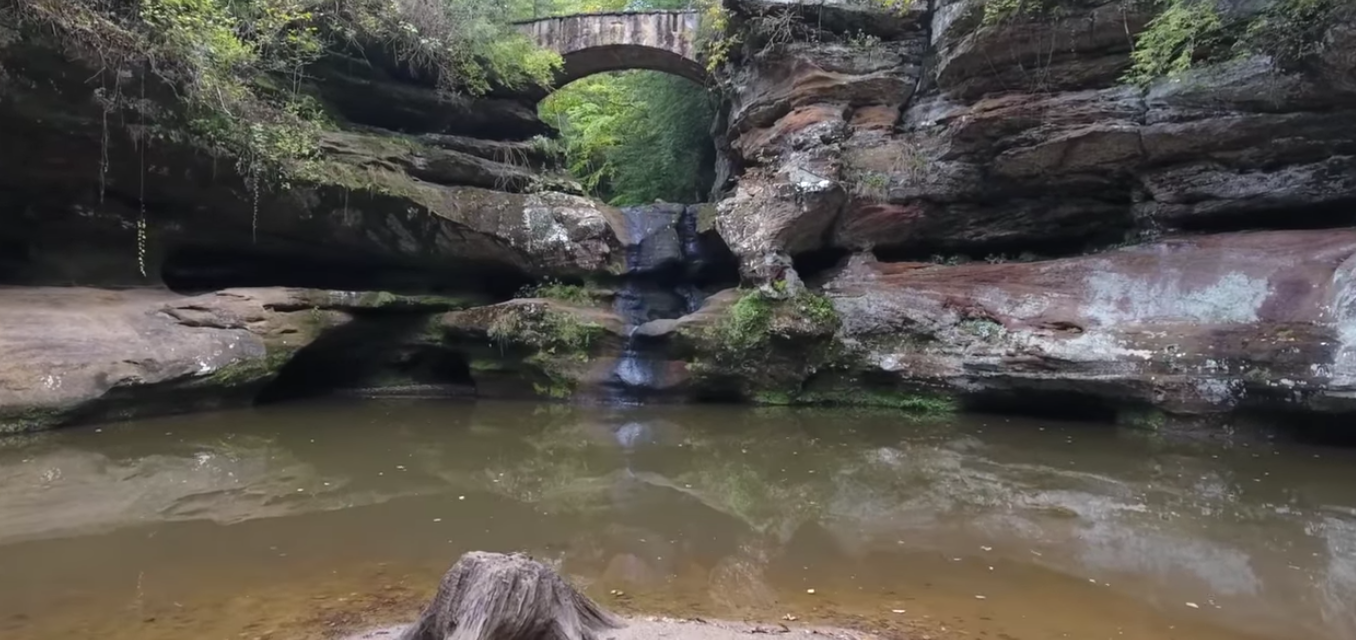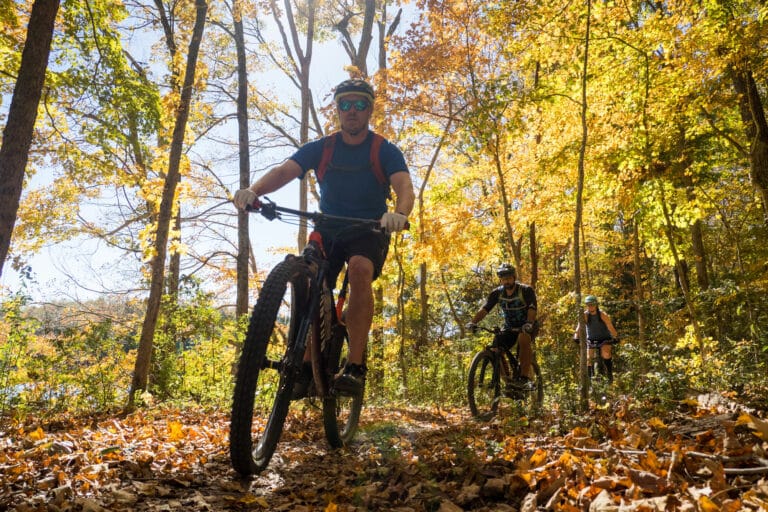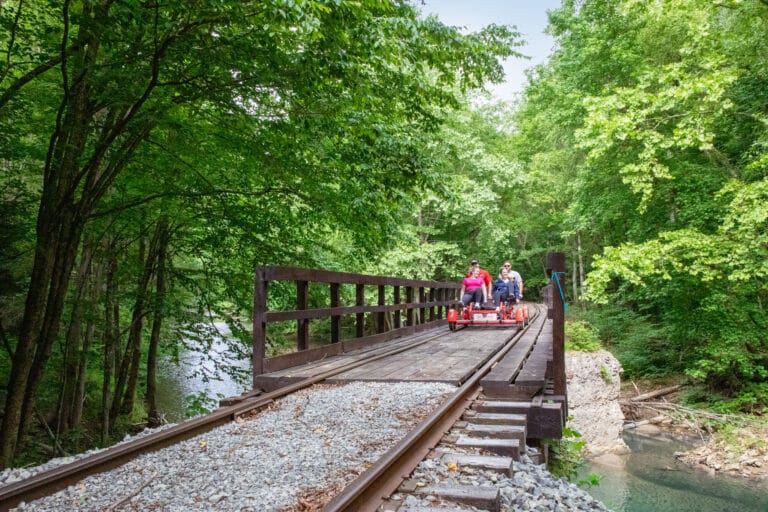As we celebrated the 100th anniversary of the U.S. national parks this past August, the citizens across the country rekindled their love with our national parks. These acclaimed parks span from the grandiose Zion, to the local Great Smoky Mountains—drawing international visitors year-round.
With all of this popularity, it’s easy to overlook the little brother of these national treasures—state parks! The U.S.’s state parks offer some of the best adventures in your state’s backyard. Climbers, hikers, bikers, and thrill-seekers of all kinds can find their niche in the state parks of the Southeast and Mid-Atlantic. Give the little guy a chance and check out some of our favorite state parks. And don’t be fooled by their size, these five parks pack a punch.
Stone Mountain State Park, North Carolina
The massive 600-foot face of a granite dome in Stone Mountain State Park towers over visitors of all walks of life. While this imposing rock keeps an eye out for the park’s many types of visitors—bikers, hikers, fishermen (and women), horseback riders—some adventurers brave the rock’s smooth surface with chalk and carabiners.
For those who prefer a bird’s eye view of this expansive Carolinian treasure, make sure to pick up a free climbing permit from the base of the mountain. Experienced climbers can find an unexpected challenge while scaling the face of the granite wall that has helped make this park so popular. For those who prefer to keep two feet on the ground, this park has more than 18 miles of trails, 90 campground sites, and more than 20 miles of designated waters filled with rainbow and brown trout. Natural surface trails such as the Black Jack Ridge Trail, Cedar Rock Trail, and Middle Falls/Lower Falls Trail wind hikers through the rugged terrain filled with diverse wildlife and striking overlooks of the lush, green landscape.
Grayson Highlands State Park, Virginia
The 4,502 acres of the Grayson Highlands State Park in Southwest Virginia will transport visitors to a landscape unlike any other. Rolling hills, the muted colors of the Blue Ridge Mountains, and long, tickling switch grass are reminiscent of the Scottish countryside with a southern twist. Near two of Virginia’s highest peaks—Mount Rodgers and Whitetop Mountain—the views from the highlands are hard to beat.
Just off the Appalachian Trail, skilled hikers and day-hikers alike can experience highlands and 5000-foot alpine peaks. As hikers trek over the sweeping hills, they might run into an unexpected new friend. Wild ponies, too, roam these parts. Released by the U.S. Forest Service to control the growth of the meadow brush, they now delight hikers with their tiny legs and big personalities.
Jockey’s Ridge State Park, North Carolina
Are the mountains not quite your scene? Check out the popular Jockey’s Ridge State Park in the Outer Banks of North Carolina to tickle your adventurous side. Hosting the largest natural sand dune in the eastern U.S., this state park offers the traditional sightseeing and not-so-traditional sand boarding and hang-gliding by permit. This park is one of the premier locations for catching the violently red and pink beach sunsets on top of the ever-changing surfaces of the dunes.
Adventurers can check out the south side of the park for the more traditional beach experience with access to sunbathing, swimming, and paddling. After venturing out into the expansive dune field, visitors can hop on the one-mile trail into the grassy dunes and wetland thickets. Jockey’s Ridge State Park’s otherworldly dunes and stunning views reinvent the run-of-the-mill trip to the beach.
Hocking Hills State Park, Ohio
Hocking Hills, nestled in the Ohio wilderness, hosts a rugged landscape perfect for hiking, biking, and camping. With six major hiking areas—Ash Cave, Cantwell Cliffs, Old Man’s Cave, Rock House, Conkle’s Hollow, and Cedar Falls—this park has varied experiences for all skill levels.
Old Man’s Cave, one of the most popular spots in the park, is a breathtaking scene of steep cliffs, flowing waterfalls, and a deep blue swimming hole. Old Man’s Cave is a romantic sanctuary surrounded by a forest bustling with thrill-seekers exploring the sandstone region of Ohio. One of the best ways to explore this park is tearing down one of the two mountain bike trails it has to offer—Purple (2 mi.) and Orange (2 mi.). Both are perfect for intermediate and expert level bikers. The Purple Trail cuts through the primitive camping area that can host individuals, families, and large groups.
Fall Creek Falls State Park, Tennessee
This 26,000-acre park is Tennessee’s largest and most popular state park. Stretched across the Cumberland Plateau, it’s home to one of the highest falls in the eastern U.S. Beyond sightseers checking out the many roaring waterfalls throughout the park, this Tennessee sanctuary is bustling with boaters, hikers, bikers, bird waters, and anglers. With over 35 miles of hiking in the park, anyone can spend his or her ideal day escaping into this lush Tennessee landscape.
Overnight trails such as The Upper Loop (14.0 mi.) or the Lower Loop (13.2 mi.) or the single day Wheeler Farm Loop cater to more experienced hikers looking for a difficult trek on a natural surface trail. There are also winding paved and unpaved bike trails ranging from six to twenty-four miles. Even those wielding binoculars and a bird book can appreciate the chirping soundtrack of the 140 species of birds found in the area.

BREAKS INTERSTATE PARK, KENTUCKY
HOW TO PLAY: Not quite a “state park,” but close enough, this 4,600-acre interstate park is one of only two interstate parks in the country. Straddling the border between southwestern Virginia and eastern Kentucky, the Breaks is managed by the two states.
Its name dates back to the mid-18th century when Daniel Boone scoured
the rugged cliffsides in search of a literal break in the 125-mile Pine Mountain ridgeline. If you’re a whitewater kayaker, the Pound and Russell Fork rivers are a literal wet dream, with regular release weekends and continuous whitewater to t everyone’s skill level. Each fall, paddlers from near and far set up camp at the Breaks to paddle either the upper class II-IV stretches of the Russell Fork or the class IV-V gorge below. In some places, the canyon walls loom over 1,600 feet above the river. Climbers looking for an escape from established crags and weekend crowds elsewhere are now, as of last year, permitted to climb and establish routes at designated areas within the Breaks. Over 25 miles of established hiking and biking trails lead to many of these climbing areas, and if you’re planning on throwing up
a route, stop by the Visitor’s Center to learn proper protocol and to pick up a free permit.
WHERE TO STAY: The park itself has a beautifully wooded campground with 138 sites, starting at $17 per night. Upgrades include sites with electric and water or, of course, a lakefront cabin or room at The Lodge.
GRAYSON HIGHLANDS STATE PARK, VIRGINIA
HOW TO PLAY: One visit to Grayson Highlands State Park will forever change how you rank Southwest Virginia as an adventure destination. Sandwiched between the quaint communities of Independence and Damascus, Va., this high-elevation park provides front door access to Virginia’s tallest mountains— Mount Rogers and Whitetop. The park
is also home to a resident miniature pony population, which is every bit as magical and endearing as it sounds.
To properly experience the highlands, you’ll need a few days and a solid pair of hiking boots. Though a small portion of the Appalachian Trail runs through the park, check out the Rhododendron or Wilson Creek trails for the opportunity to gorge on wild blueberries or catch the elusive native brook trout. In addition to hikers and equestrians, boulderers are beginning to take more notice of the park for its plentiful boulder elds. The park has a bouldering guidebook on sale at the Visitor’s Center, and out-of-town climbers can even rent a crash pad for the day.
WHERE TO STAY: Backpackers will find no shortage of places to set up camp within the park, but for those who are trying to forgo the tent, space at the Thomas Knob Shelter lls up quickly. If you’re in need of a hot shower and some electricity, Grayson Highlands’ campground sites run about $20 per night.
BLACKWATER FALLS STATE PARK, WEST VIRGINIA
HOW TO PLAY: No matter the season, or the sport, Blackwater Falls State Park serves up the ultimate adventure sampler. Elite paddlers will tackle the classic class V Upper Blackwater, which runs regularly throughout the winter and spring months. If white-knuckling down a steep creek in the dead of winter with the potential for serious consequences isn’t for you (we don’t blame you), hikers and mountain bikers can take to the diverse offering of trails in the park, from the Blackwater Canyon rail-trail to the rooty goodness of the Balsam Fir Trail. Everyone should make a point of visiting the six-story falls for which the park is named. Here, the amber-colored waters of the river tumble over 60 feet into the canyon below, and after particularly brutal cold snaps, the falls often freeze over. After a solid snow, the park takes on an ethereal Narnia-like quality. Ski beneath the snow-laden limbs of hemlock and spruce trees on the park’s groomed cross-country ski trails, or grab a sled and take a run down the sledding hill. Year-round cyclists will even nd some good fat biking here and can take a rip on one of Blackwater Bike’s rental rides.
WHERE TO STAY: Open the last weekend of April until October 31, the Blackwater Falls campground is a primo place to post up. Sites start at $22 per night and can be reserved for up to two weeks at a time.
ASSATEAGUE STATE PARK, MARYLAND
HOW TO PLAY: Hemmed in by the crystal-blue waters of the Atlantic Ocean to the east and the Sinepuxent Bay to the west, Maryland’s only state park is a quiet alternative for beach lovers. Nine miles south of the tourist bonanza that is Ocean City, Assateague caters to the adventurous tourists who aren’t afraid to work for their fun. Grab a sit-on-top kayak and paddle out past the break from the park’s boat launch facilities. Bring a rod for some saltwater angling, or hop off the boat and dig deep for clams. Paddling the western bayside shore of Assateague gets you up-close and personal with the island’s marsh environment where insular coves and plentiful waterfowl sightings will keep you exploring for hours. The island is biker-friendly, with a four-mile paved bike path running the length of the park, so you can access any part of the beach without the worry of traf c. Sunburns and mosquito bites aside, the only real concern you’ll have on Assateague is having your beach camp raided by feral horses.
WHERE TO STAY: From $11.75 a night, the Assateague State Park campground situates campers just a stone’s throw away from the beach, which is cordoned off from the campsites by sand dunes.
LAUREL RIDGE STATE PARK, PENNSYLVANIA
HOW TO PLAY: Be it the subtle shades of pink and white from blooming mountain laurel or the vibrant squash oranges and yellows of peaking fall foliage, this southwestern Pennsylvania jewel of a park is stunning in every season. Its backbone and namesake, the Laurel Highlands Hiking Trail, traces the Laurel Mountain ridgeline for 70 miles from the Youghiogheny River in Ohiopyle to the Conemaugh Gorge near Johnstown. Though backpacking and day hiking are the most popular adventures in the park, there are a number of sections of the Laurel Highlands Hiking Trail that, given the right amount of snow, are navigable by cross-country ski. Additionally, the park operates a cross-country ski touring concession where visitors can rent skis, take ski lessons, and skate on over 18 miles of groomed trails. Not a skier? Rent a pair of snowshoes for the day! Snowshoeing is a rewarding way to take to the trails, but some coordination is required.
WHERE TO STAY: Hikers can opt for a lightweight setup and ditch the tent on the Laurel Highlands Hiking Trail, as there are eight shelters situated every six to 12 miles along the trail’s 70-mile route. Traditional car campers will want to stake a site at the Laurel Ridge State Park campground, where you can grab a site starting at $17 per night.
BEST OF THE REST
More of our favorite state parks, forests, and recreation areas:
COOPERS ROCK STATE FOREST
BRUCETON MILLS, WEST VIRGINIA
HOW TO PLAY: Rope up on the Sunset Wall and The Big Blocks climbing areas. With over 50 routes ranging from 5.2 through 5.12, these walls afford the out-of-town climber a tantalizing taste of the endless climbing Coopers Rock has to offer.
WHERE TO STAY: Pitch a tent at the state forest campground for $28 per night. All sites come with electric and WiFi is available.
NORTH BEND STATE PARK
CAIRO, WEST VIRGINIA
HOW TO PLAY: Bring the entire family for a bike ride along the North Bend Rail Trail. This 72-mile multiuse trail takes visitors back in time through historic tunnels and railroad hubs from decades past.
WHERE TO STAY: Two campgrounds, River Run and Cokeley Campgrounds, offer out-of-towners plenty of chances to rough it with sites starting at $22 per night. For a few modern-day luxuries, the lodge has rooms starting $60 per night during the week.
DOUTHAT STATE PARK
MILLBORO, VIRGINIA
HOW TO PLAY: Loop up the 18.2-mile Douthat IMBA Epic. The park’s 40 miles of singletrack here can be fast and dry or rocky and technical, so pick your poison.
WHERE TO STAY: Sites at the park campground start at $26 per night for standard sites. A popular option among groups of riders staying for the weekend is to throw down on a cabin, which requires a minimum two-night stay and starts at $62 per night.
NEW RIVER TRAIL STATE PARK
MAX MEADOWS, VIRGINIA
HOW TO PLAY: Hike, bike, or ride your horse along this 57-mile linear park. Most of the trail follows the New River as it winds through four southwest Virginian counties and countless historical sites.
WHERE TO STAY: You won’t nd any cabins here, but there are four primitive campgrounds you’ll encounter along the way. Rates start at $15 per site.
FROZEN HEAD STATE PARK
WARTBURG, TENNESSEE
HOW TO PLAY: Learn firsthand why competitors in the now notorious Barkley Marathons consider Frozen Head’s terrain some of the steepest, and most beautiful, in the region. Hike the Lookout Tower Trail and climb the re tower for outstanding 360-degree views of the Cumberland Plateau and the Great Smoky Mountains.
WHERE TO STAY: Reserve early for one of Frozen Head’s 10 backcountry tent sites along the park’s 50+-mile trail system. Not into backpacking but still want a primitive camping feel? There are two campgrounds here, Flat Fork and Big Cove, offering sites ranging from $13.75-$24 per site, per night.
PINE MOUNTAIN STATE RESORT PARK
PINEVILLE, KENTUCKY
HOW TO PLAY: Hike all 12 miles of trails within the park to exotic points of interest like Chained Rock, Hemlock Garden, and Honeymoon Falls.
WHERE TO STAY: Two double bed rooms at the lodge start at $53.96 per night.
CUMBERLAND FALLS STATE RESORT PARK CORBIN, KENTUCKY
HOW TO PLAY: Take a trek to the 125-foot-wide curtain of water for which this state park was named. If the skies are clear, and a full moon is out, consider hiking at night to catch a glimpse of the moonbow, or lunar rainbow, which appears at the base of the falls.
WHERE TO STAY: Stake out camp at the Cumberland Falls campground. Tent sites run about $17 per night while standard campsites start at $22 per night.
DUPONT STATE RECREATIONAL FOREST CEDAR MOUNTAIN, NC
HOW TO PLAY: Set off on a six-mile hike early. You’ll want plenty of time to take pictures of, and dips in, the six stunning waterfalls you’ll pass along the way, many of which were featured in the hit blockbuster The Hunger Games.
WHERE TO STAY: There’s no camping allowed within forest boundaries, but just four miles down the road is Black Forest Family Camping Resort. Basic tent sites run about $31 per night if you bring cash.
TABLE ROCK STATE PARK
PICKENS, SOUTH CAROLINA
HOW TO PLAY: Rent a kayak for $5 per half-hour to oat-and- sh the scenic, 36-acre Lake Pinnacle.
WHERE TO STAY: Visitors can stay at the park’s campground for $25 per night or at one of the park’s six primitive trailside sites for $17 per night per site.
CLOUDLAND CANYON STATE PARK
RISING FAWN, GEORGIA
HOW TO PLAY: Experience the spectacular 1,000-foot gorge on any number of Cloudland’s 30 miles of trails, which are open to hikers and bikers alike.
WHERE TO STAY: On a budget? Backcountry campsites in the park are only $8 per night. For a more unique lodging experience, check out one of the yurts starting at $100 per night.
AMICALOLA FALLS STATE PARK
DAWSONVILLE, GEORGIA
HOW TO PLAY: Hike to the base of the 729-foot Amicalola Falls, considered the tallest cascading waterfall in the Southeast, before trekking the 8.5 miles north along the Appalachian Trail to get a taste of thru hiker life.
WHERE TO STAY: Campsites at the park start at $40 per night, but for a truly authentic lodging experience, hike to the Len Foote Hike Inn, which requires a ve-mile trek in. Single occupancy rates are $122 per night, but include a family-style dinner and breakfast.







